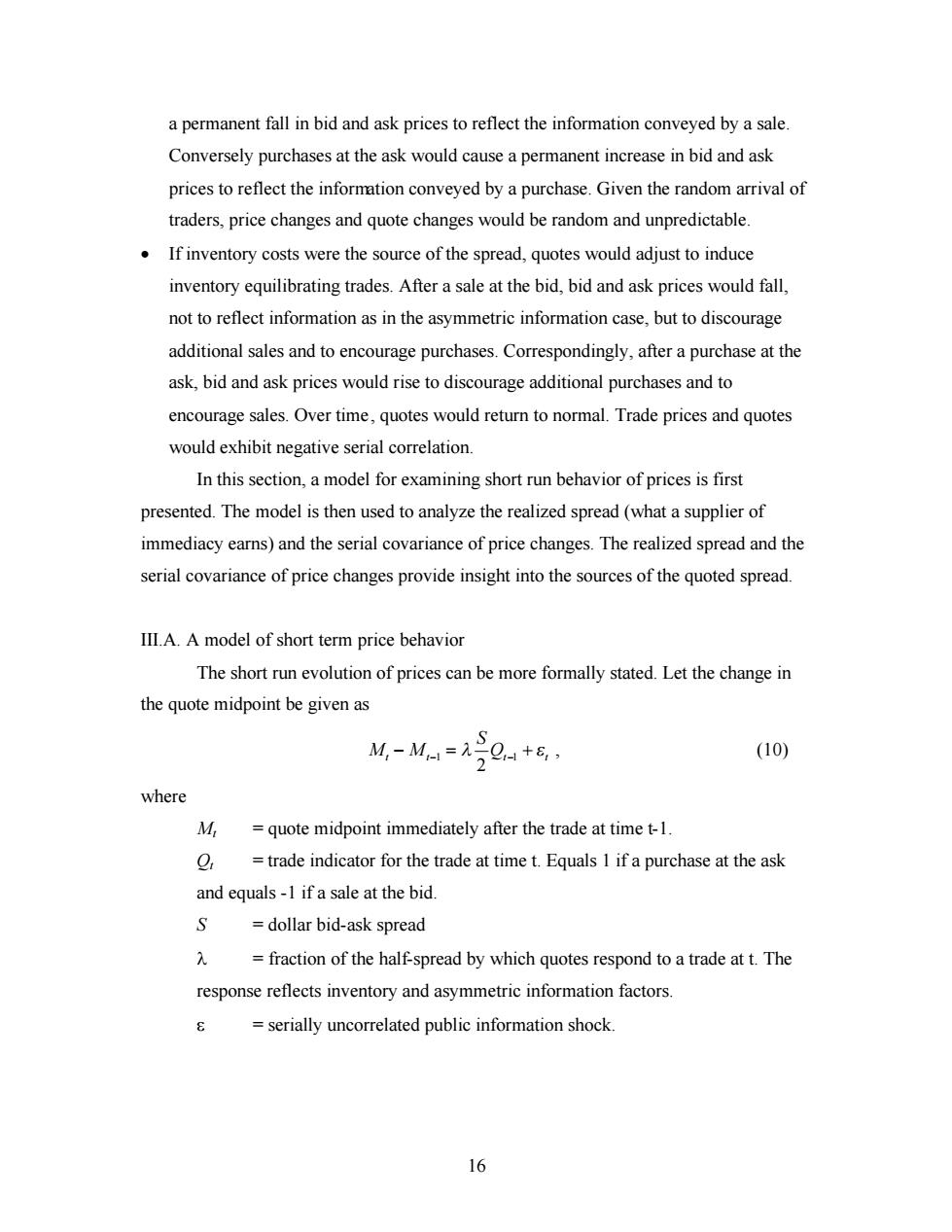正在加载图片...

a permanent fall in bid and ask prices to reflect the information conveyed by a sale. Conversely purchases at the ask would cause a permanent increase in bid and ask prices to reflect the information conveyed by a purchase.Given the random arrival of traders,price changes and quote changes would be random and unpredictable. If inventory costs were the source of the spread,quotes would adjust to induce inventory equilibrating trades.After a sale at the bid,bid and ask prices would fall, not to reflect information as in the asymmetric information case,but to discourage additional sales and to encourage purchases.Correspondingly,after a purchase at the ask,bid and ask prices would rise to discourage additional purchases and to encourage sales.Over time,quotes would return to normal.Trade prices and quotes would exhibit negative serial correlation. In this section,a model for examining short run behavior of prices is first presented.The model is then used to analyze the realized spread(what a supplier of immediacy earns)and the serial covariance of price changes.The realized spread and the serial covariance of price changes provide insight into the sources of the quoted spread. III.A.A model of short term price behavior The short run evolution of prices can be more formally stated.Let the change in the quote midpoint be given as S M,-M-1=元9Q,+6, (10) 2 where M quote midpoint immediately after the trade at time t-1. Q =trade indicator for the trade at time t.Equals 1 if a purchase at the ask and equals-1 if a sale at the bid. S dollar bid-ask spread 入 fraction of the half-spread by which quotes respond to a trade at t.The response reflects inventory and asymmetric information factors serially uncorrelated public information shock. 1616 a permanent fall in bid and ask prices to reflect the information conveyed by a sale. Conversely purchases at the ask would cause a permanent increase in bid and ask prices to reflect the information conveyed by a purchase. Given the random arrival of traders, price changes and quote changes would be random and unpredictable. · If inventory costs were the source of the spread, quotes would adjust to induce inventory equilibrating trades. After a sale at the bid, bid and ask prices would fall, not to reflect information as in the asymmetric information case, but to discourage additional sales and to encourage purchases. Correspondingly, after a purchase at the ask, bid and ask prices would rise to discourage additional purchases and to encourage sales. Over time, quotes would return to normal. Trade prices and quotes would exhibit negative serial correlation. In this section, a model for examining short run behavior of prices is first presented. The model is then used to analyze the realized spread (what a supplier of immediacy earns) and the serial covariance of price changes. The realized spread and the serial covariance of price changes provide insight into the sources of the quoted spread. III.A. A model of short term price behavior The short run evolution of prices can be more formally stated. Let the change in the quote midpoint be given as 1 1 , 2 t t t t S M M Q l e - - - = + (10) where Mt = quote midpoint immediately after the trade at time t-1. Qt = trade indicator for the trade at time t. Equals 1 if a purchase at the ask and equals -1 if a sale at the bid. S = dollar bid-ask spread l = fraction of the half-spread by which quotes respond to a trade at t. The response reflects inventory and asymmetric information factors. e = serially uncorrelated public information shock